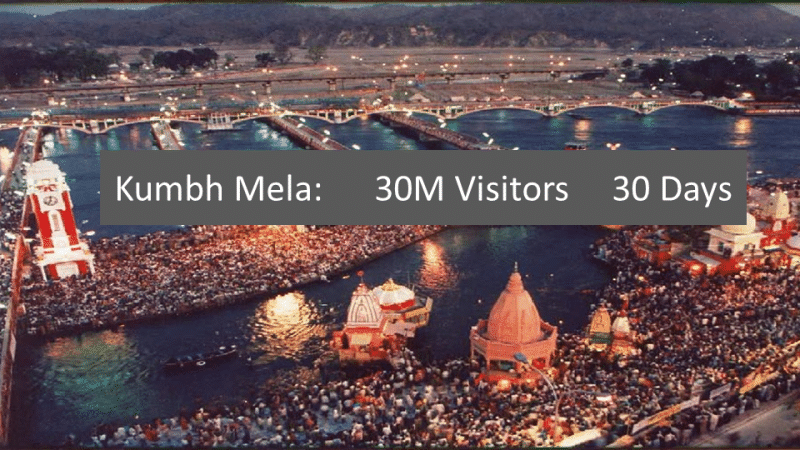The Majestic Ujjain Kumbh Mela
Man does not even know the exact age of the biggest religious gathering on the face of planet Earth, this festival is one long-standing affaire. There is no concrete evidence pointing to the origin of it, but it touted to be happening since medieval times.
All religions believe that the destiny of mankind is determined by the celestial war that differentiates the right from wrong and good from evil. All festivals, in essence, are a celebration of the victory of good. So is this one. Welcome to the biggest mass pilgrimage of Hindu’s ever; the festival of Kumbh, or more popularly known as the ‘Kumbh Mela’. It’s one big fest where the Hindu’s gather to bathe in a sacred river. This activity of bathing in these sacred rivers is thought as a process of cleansing that person of all his sins. The fair takes place at 4 designated places by turn; every 3 years. So, any of these places witnesses the Kumbh Mela happening every 12 years.

The festival is organised on the ghats of Ganga at Haridwar, confluence of Ganga, Yamuna and Sarasvati at Allahabad, Godavari at Nashik and that of Kshipra at Ujjain. Rig Veda has a mention about the significance of convergence of river Ganges, Yamuna and Saraswati at Prayag or Sangam.
Kumbh means ‘vessel’ and ‘mela’ means a festival. At the root of the Kumbh Mela, its essence is that over the issue of capturing the nectar of immortality that would end the war between the gods and the demons. Mythology has it and is mentioned in The Bhagvad Purana verses that there once was a battle between demigods (Devas) and demons (Asuras). Lord Indra had offended Durvasa, a sage and the Devas had lost all their power. The demigods ran to Lord Vishnu, who came into a situation of a pact with the Asuras to churn the ocean of milk, the ‘Ksheer Sagar’ to obtain ‘Amrit’, the nectar of immortality. It was the divine physician ‘Dhanavantari’ who emerged with a kumbh (pot) of amrit after the ocean was churned. As soon as the nectar appeared, Lord Vishnu handed the jug to Garuda, who was to take it to the safety of heaven.

Garuda’s this crusade lasted for 12 demigod days, which was equal to about 12 human years. he was then obstructed by the demons at and was forced to place the kumbha or vessel of nectar down at Prayag, Nashik, Ujjain, and Haridwar. Some of the nectar spilled at each of these aforementioned 4 places, sanctifying them and attaching with them a religious value, forever. That is why Kumbh is held every 12 years at these four places.

For 2016, it’s Ujjain’s turn to play host to the festival of Kumbh, the ‘Simhastha Kumbh mela’. Situated on the banks of river Kshipra, Ujjain is found in Madhya Pradesh. The Kumbh Mela at Ujjain began in the 18th century, when the Maratha ruler Ranoji Shinde invited ascetics (Vaishnav Bairagi’s) from Nashik to Ujjain for a local festival and takes place when the position of Jupiter ascends that into Leo or the Simha constellation, hence giving rise to the name ‘Simhastha’.
Ujjain is the seat of Mahakal- The Lord of all times.

